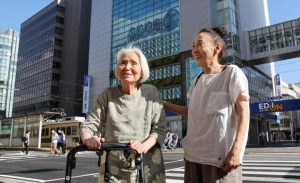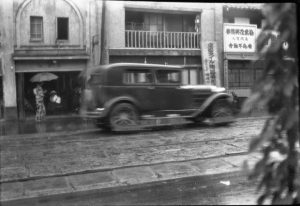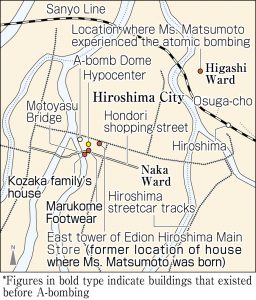Striving to fill voids in Hiroshima―Recreating cityscapes: Born in former Sarugaku-cho, Ms. Matsumoto retains memories of her youth
Aug. 3, 2022
Photograph “reunited” her with house where she was born
by Rina Yuasa, Staff Writer
Sachiko Matsumoto, a resident of Hiroshima’s Minami Ward, still has a pair of Japanese wooden geta footwear she bought at a shop called Marukome Footwear, located at the atomic bombing hypocenter (defined as the location on the ground directly beneath the A-bomb’s detonation). Even now, at the age of 97, Ms. Matsumoto cherishes her fond memories of the area in Hiroshima that was known as Sarugaku-cho, where she was born and raised, and the former Saiku-machi (both now part of the city’s Naka Ward). Although she was able to avoid experiencing the atomic bombing at the hypocenter, her life changed drastically after the war. Thinking of her home, demolished in the A-bombing, she now hopes for peace.
“Things have changed considerably around here,” said Ms. Matsumoto in late July, when she and her oldest daughter, Etsuko Oka, 73, a resident of Hiroshima’s Naka Ward, walked around the former Sarugaku-cho, the area in which Ms. Matsumoto’s house once stood and where she lived until she was 18. Close to the major intersection in the downtown area of Kamiya-cho, the location of her former house is now occupied by the east tower of the Edion Hiroshima Main Store.
Found image of family house among 2,000 photos
The first floor housed a shop called Mutual Finance Hiroshima Fudokai, a financial business run by Ms. Matsumoto’s father, Goro Kiyoyoshi, who passed away in 1980 at the age of 84; the second floor was used as the family residence. In her childhood, Ms. Matsumoto would play on the nearby Western Drill Ground, used by the Japanese military, with a girl by the name of Shi-chan, who lived across the way from her house. After graduating from a girls’ high school, Ms. Matsumoto learned Japanese dressmaking at the Kozaka family’s house in the same neighborhood as Marukome Footwear. As if it were yesterday, she explained that the second floor was a classroom, with some people who worked there living on the premises.
The Matsumoto family’s business was doing well at the time. She clearly recalls employees cycling from and back to the shop on money-collection routes. “But I don’t have a single photo of the house before the war,” she said.
She had a suspicion, however, that there were photos around somewhere. The person Ms. Matsumoto knew as Shi-chan is Shizue Kawamoto, 97, a resident of Hatsukaichi City in Hiroshima Prefecture. Her house in those days was a photo studio run by her father, the late Wakaji Matsumoto, who was known for taking many photos of the city center before the A-bombing. When this reporter inquired of a relative of Ms. Kawamoto, he found a photo that included a sign with “Hiroshima Fudokai” on the other side of the streetcar line, among a total of around 2,000 photos.
Ms. Matsumoto said, “I miss those days. The photo brings back memories.” The photo “reunited” her with the family house of her memory for the first time in 77 years, bringing a smile to her face. Her daughter, Ms. Oka, also looked at the photo and said, “So this was where you lived?”
Sewing skills supported family
Ms. Matsumoto and her family moved to the area of Futabanosato (now part of Hiroshima’s Higashi Ward) around 1944, but her family’s business continued in Sarugaku-cho. Later, she married Masaru, an officer in the former Japanese Army, and moved to Kanagawa Prefecture. Shortly after she had returned to Hiroshima for her pregnancy, in the summer of 1945, the atomic bomb was dropped on the city. Pregnant and reading a book in the yard of her home about 1.7 kilometers from the hypocenter, Ms. Matsumoto suffered burns to her face and right hand and leg. Her father and the rest of the family were safe, as the bombing happened before they left the house for work in Sarugaku-cho.
People with severe burns were fleeing from the city center. Ms. Matsumoto said, “They crawled along and ran out of strength along the way. I felt so sorry for them.” Her house was destroyed by the A-bomb blast, but her family took in numerous wounded strangers in their yard.
The entire area including Sarugaku-cho and Saiku-machi, along with the neighborhoods and people there, was annihilated. Only a huge iron safe-deposit vault remained at the Hiroshima Fudokai shop, located about 190 meters from the hypocenter. Sachiko’s husband, Masaru, returned to Hiroshima three days later, staying in the burnt ruins of the shop and sleeping in the vault at night. The vault’s whereabouts after that time are unknown. The family business was never resumed.
The sewing skills she had learned in Saiku-machi before the bombing helped support their lives after the war. She opened a clothing store near the Kyobashi River in the area of Osuga-cho (now part of Hiroshima’s Minami Ward), where she sewed and sold fundoshi, a traditional Japanese undergarment. Since moving to the west side of the JR Hiroshima Station in 1959, her home has been located on a corner in Eki-nishi, an area with restaurants that retain a historical ambience from the Showa Era (1926–1989).
Now, Ms. Matsumoto is concerned about the increasing number of media reports indicating that nuclear weapons could be used again. “The A-bombing was truly horrifying. Such a time should never be repeated.”
(Originally published on August 3, 2022)










